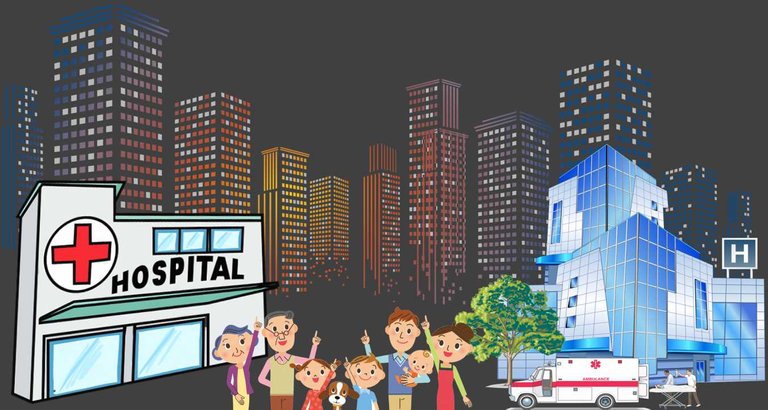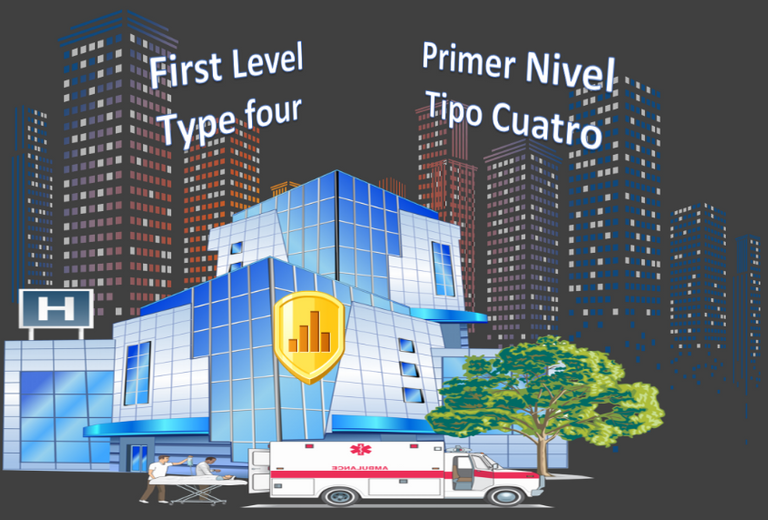Los Hospitales y Datos Curiosos🏥/ Hospitals and Fun Facts🏥

Los Hospitales y Datos Curiosos
Hospitals and Fun Facts
Muy buenas amigos lectores, en esta oportunidad les voy a mostrar información sobre los hospitales que estoy seguro que desconocen. Así que vamos allá!!
Good morning readers, this time I'm going to show you some information about hospitals that I'm sure you don't know. So here we go!
Como ya sabrás los hospitales son un componente importante del sistema de atención de salud. Son instituciones sanitarias que disponen de personal médico y otros profesionales organizados y de instalaciones para el ingreso de pacientes, y que ofrecen servicios médicos y de enfermería y otros servicios relacionados durante las 24 horas del día, los 7 días de la semana.
As you may know, hospitals are an important component of the health care system. They are healthcare institutions that have organised medical and other professional staff and facilities for the admission of patients, and provide medical, nursing and related services 24 hours a day, 7 days a week.
Generalmente orientados a la atención individual, los hospitales tienden cada vez más a estrechar vínculos con otras partes del sector de la salud y con las comunidades a fin de optimizar el uso de los recursos dedicados a fomentar y proteger la salud individual y colectiva.
Generally oriented towards individual care, hospitals are increasingly seeking closer links with other parts of the health sector and with communities in order to optimise the use of resources dedicated to promoting and protecting individual and collective health.
Hasta este punto algunos deben estar familiarizados con lo que son los hospitales, pero ¿sabias que los hospitales se clasifican?, ¿sabes cuales son los puntos esenciales para clasificar a un hospital?, Estas preguntas te las iré contestando paso a paso.
By now some of you may be familiar with what hospitals are, but did you know that hospitals are classified, do you know what are the essential points to classify a hospital, I will answer these questions step by step.

La mayoría habrá pensado que se clasifican según la capacidad de personas atendidas, y pues esto es cierto, es un punto esencial !pero no es el único!.
Most people will have thought that they are classified according to the capacity of people served, and this is true, it is an essential point, but it is not the only one!

- Según ámbito de actuación: estos pueden ser Estatal (regional) los cuales son los hospitales de referencia, Comarcal los de este tipo deben tener entre 50-100 camas y por ultimo están los local más conocidos como dispensarios, ambulatorios o sanatorios.
- According to their scope of action: these can be State (regional), which are the hospitals of reference, Regional, those of this type must have between 50-100 beds and finally there are the local ones better known as dispensaries, outpatient clinics or sanatoriums.
- Según su dependencia: si estos están bajo la administración publica se suelen denominar hospitales, y si son privados se les dice clínicas.
- Depending on their dependence: if they are under public administration, they are usually called hospitals, and if they are private, they are called clinics.

- Según su función: Generales y Especiales.
- According to their function: General and Special.
- Según permanencia del enfermo: Hospital de día, Hospital de noche y Hospital de Atención Continuada.
- Depending on the length of stay of the patient: Day Hospital, Night Hospital and Continuing Care Hospital.

- Hospital de primer nivel (Europa) u hospitales tipo 4 (América latina): Los hospitales de primer nivel pueden variar los requisitos dependiendo del país, en Venezuela suelen tener un rango de acción para una población a partir de los 100.000 habitantes y con un ara de influencia de un millón de habitantes; Son centros de referencia para los entes sanitarios de la región, así mismo ocurre en otros países por lo menos en España atienden a medio millón de habitantes en adelante. Estos deberán disponer de todas las técnicas invasivas y no invasivas de las diferentes especialidades, así como de un programa de formación de futuros especialistas en diferentes carreras profesionales de la salud.
- First level hospitals (Europe) or type 4 hospitals (Latin America): The requirements for first level hospitals may vary depending on the country. In Venezuela they usually have a range of action for a population of 100,000 inhabitants or more, with an area of influence of one million inhabitants; they are reference centres for the health authorities of the region, as is the case in other countries, at least in Spain, where they serve half a million inhabitants and more. They must have all the invasive and non-invasive techniques of the different specialities, as well as a training programme for future specialists in different health careers.

Hospital de segundo nivel (Europa) u Hospitales tipo 3 (América Latina): Similar al anterior. En Venezuela al igual que en España estos hospitales tienen un rango poblacional de atención media de 250.000 habitantes, disponen de servicios de medicina interna, pediatría, cirugía general y ginecología - obstetricia; laboratorios, rayos X por 24 hora, odontología, cirugía ambulatoria y especializada, sub-especialidades, terapia intensiva, entre otros y deben presentar la estadísticas a las autoridades municipales.
Second level hospitals (Europe) or type 3 hospitals (Latin America): Similar to the previous one. In Venezuela, as in Spain, these hospitals have an average population range of 250,000 inhabitants, have internal medicine, paediatrics, general surgery and gynaecology-obstetrics services, laboratories, 24-hour X-rays, dentistry, outpatient and specialised surgery, sub-specialties, intensive care, among others, and must submit statistics to the municipal authorities.
Hospital de tercer nivel (Europa) u hospital tipo 2 (América Latina): Están ubicados en poblaciones de 20.000 a 100.000 habitantes, cuentan con servicios de medicina interna, pediatría, cirugía general, ginecología - obstetricia; laboratorios, rayos X, odontología y cirugía ambulatoria.
Third level hospital (Europe) or type 2 hospital (Latin America): They are located in towns of 20,000 to 100,000 inhabitants, with internal medicine, paediatrics, general surgery, gynaecology-obstetrics; laboratories, X-rays, dentistry and outpatient surgery.
Hospitales comarcales (Europa) u hospitales tipo 1 (América Latina): ubicados en poblaciones de 20.000 a 60.000 habitantes, cuentan con servicio de medicina interna, pediatria, cirugia general y ginecología - obstetricia, laboratorio, rayos X y odontología.
Regional hospitals (Europe) or type 1 hospitals (Latin America): located in towns of 20,000 to 60,000 inhabitants, they have internal medicine, paediatrics, general surgery and gynaecology-obstetrics, laboratory, X-ray and dentistry services.

En algunos países se sigue utilizando como punto importante las cantidades de camas que posee un hospital, pero en vista que la población mundial va creciendo y haciendo uso mas constante de los hospitales, este requisito se ha ido dejando de lado.
In some countries, the number of beds in a hospital is still used as an important point, but as the world's population is growing and making more constant use of hospitals, this requirement has been dropped.

Para explicarles lo que les acabo de decir con respecto a las camas, se los mostrare de esta manera, según el punto de las camas un hospital de primer nivel o tipo 4 las cantidades de camas deberían estar a partir de 300, los de segundo nivel o tipo 3 deberían empezar a partir de 150 camas, los de tercer nivel o tipo 2 a partir de 60 camas y los comarcales o tipo 1 a partir de 20 camas. Esto ya no es tan exigente ya que en algunos de segundo nivel o tipo 3 pueden superar en camas a los de primer nivel o tipo 4, debido al uso constante de esas camas y el crecimiento poblacional en la región.
To explain what I have just told you with regard to beds, I will show you in this way, according to the point of beds, a first level or type 4 hospital should have 300 beds or more, a second level or type 3 hospital should have 150 beds or more, a third level or type 2 hospital should have 60 beds or more, and a regional or type 1 hospital should have 20 beds or more. This is not so demanding as some of the second level or type 3 can have more beds than the first level or type 4, due to the constant use of these beds and the population growth in the region.

1. Los hospitales universitarios son mejores: en cuanto a los procedimiento quirúrgicos se refiere, si los hospitales universitarios son mejores, ya que su tasa de error es mínima y su nivel de investigación y acción con respecto a nuevas patologías es muy avanzada, ademas que hay mas miradas y oídos de estudiantes que hace que no se cometan errores.
1. University hospitals are better: as far as surgical procedures are concerned, yes, university hospitals are better, as their error rate is minimal and their level of research and action with regard to new pathologies is very advanced, plus there are more eyes and ears of students, which means that mistakes are not made.
2. En los hospitales se esteriliza todo: esto es cierto en lo personal, una de mis tareas es verificar que se cumpla los procesos de esterilazación de muchos equipos e instrumental, con la finalidad de preservar la bioseguridad del paciente como del personal.
2. In hospitals everything is sterilised: this is true personally, one of my tasks is to verify that the sterilisation processes of many equipment and instruments are complied with, in order to preserve the biosafety of the patient and the staff.
3. No debes hablarle a la enfermera durante el procedimiento: Estudios han comprobado que cuando se distrae al personal de enfermería ocurren muchos errores. De hecho por cada interrupción aumenta el 12% de probabilidad de error.
3. Don't talk to the nurse during the procedure: Studies have shown that many errors occur when nursing staff are distracted. In fact, for every interruption, the probability of error increases by 12%.

4. Hacen mas pruebas de las necesarias: del 15% al 30% de las pruebas y procedimientos que se realizan, son innecesarias. Es en parte debido a la demanda del paciente, pero tambien porque muchas veces es necesario para dar un diagnostico certero.
4. They do more tests than necessary: 15% to 30% of the tests and procedures performed are unnecessary. This is partly due to patient demand, but also because it is often necessary to give an accurate diagnosis.
5. Los hospitales podrían desaparecer en el futuro: solo de la manera en como los conocemos, ya que el ideal es que el paciente pase el mayor tiempo posible en su casa, por esto es que cada día la ingeniería biomédica hace un gran esfuerzo en el desarrollo de la tecnología sanitaria a distancia (Telemedicina), buscado la manera de dar un servicio de calidad sin que usted se mueva de su casa.
5. Hospitals could disappear in the future: only in the way we know them, since the ideal is that the patient spends as much time as possible at home, which is why every day biomedical engineering makes a great effort in the development of remote health technology (Telemedicine), looking for a way to provide a quality service without you leaving your home.

Espero les haya gustado esta informacion, se que es algo basico pero que muy pocos conocen, conocer las clasificaciones de los hospitales es tan importante que nos ayudara a donde acudir cuando presentemos algun tipo de patologia compleja.
I hope you liked this information, I know it is something basic but that very few know, knowing the classifications of hospitals is so important that it will help us where to go when we present some kind of complex pathology.
No te olvides de darle a la barra de votos y compartir, sígueme y estate atento al próximo post sobre los 50 consejos que no sabías de la ciencia médica.
Don't forget to hit the vote bar and share, follow me and stay tuned for the next post about the 50 tips you didn't know about medical science.
Este post es 100% original.
Todo el Contenido de este post es de mi autoria.
This post is 100% original.
All the content of this post is of my authorship.
Congratulations @josdad01! You have completed the following achievement on the Hive blockchain and have been rewarded with new badge(s):
Your next target is to reach 3500 upvotes.
You can view your badges on your board and compare yourself to others in the Ranking
If you no longer want to receive notifications, reply to this comment with the word
STOPCheck out the last post from @hivebuzz:
Support the HiveBuzz project. Vote for our proposal!